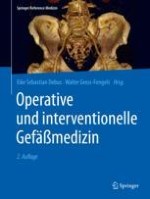Zusammenfassung
Iliakalaneurysmen werden häufig bei Patienten mit Bauchaortenaneurysmen beobachtet, können oder aber auch vollkommen isoliert im Bereich sämtlicher Iliakalgefäße auftreten. Aufgrund der Rupturgefahr stellen Iliakalaneurysmen ein potenziell tödliches Krankheitsbild dar. Somit ist auch bei dieser Krankheitsentität eine sorgfältige Risiko-/Nutzenabwägung zur Festlegung der Behandlungsindikation erforderlich, da eine Aneurysmaausschaltung mit signifikanten Komplikationen für den Patienten verbunden sein kann.











